Sodium-Ion Battery Market by Battery Type (Sodium-Sulfur, and Sodium-Salt), Technology Type (Aqueous and Non-Aqueous), End-Use (Energy Storage, Automotive, and Industrial), and Region (Asia Pacific, Europe, and North America) - Global Forecast to 2028
Updated on : April 23, 2024
Sodium-Ion Battery Market
The global sodium-ion battery market was valued at USD 0.5 billion in 2023, and is projected to reach USD 1.2 billion by 2028, growing at 21.5% cagr from 2023 to 2028. Sodium ion batteries are relatively more cost effective when compared to other batteries like lithium-ion batteries and this therefore drives the growth in sodium ion battery market. Sodium ion batteries find applications in multiple industries such as automotive, consumer electronics, industrial, and energy storage.
Attractive Opportunities in the Sodium Ion Battery Market
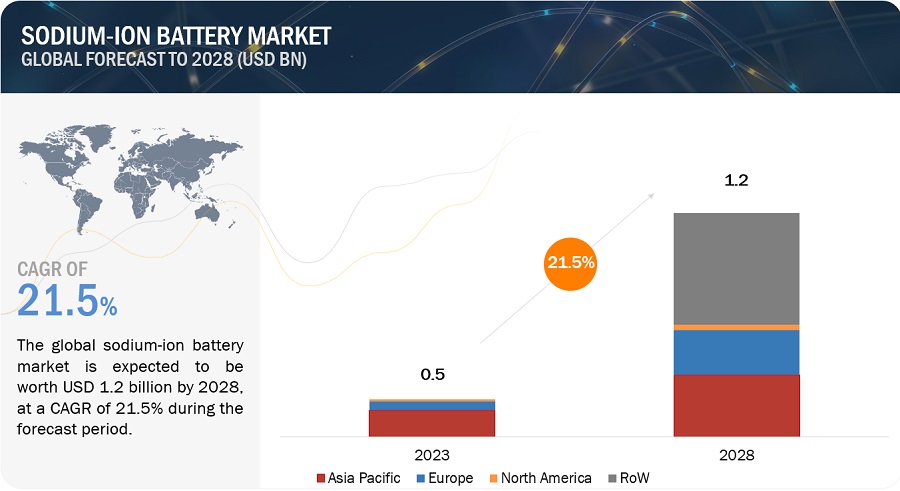
To know about the assumptions considered for the study, Request for Free Sample Report
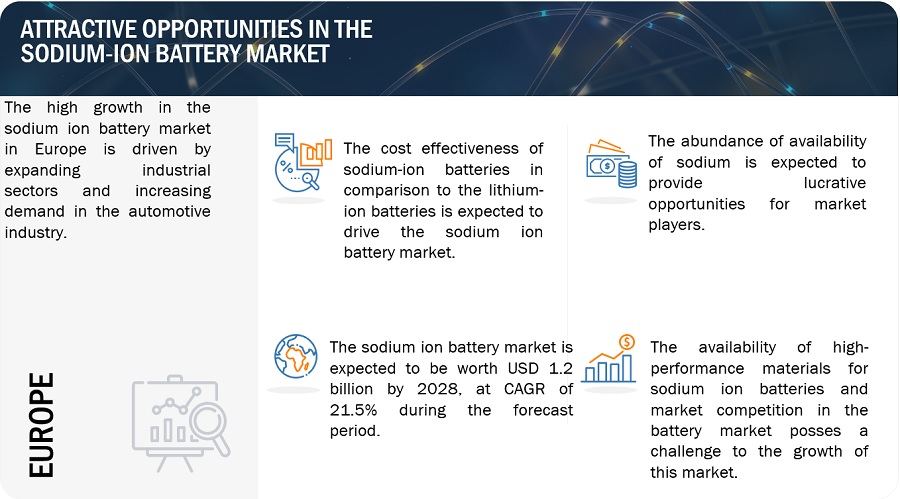
Sodium-Ion Battery Market Dynamics
Driver: Cost effective when compared to lithium-ion batteries
Sodium-ion batteries are a relatively cost-effective solution when compared to lithium-ion batteries. They offer significant advantages across various aspects of energy storage. Sodium-ion batteries are relatively cheaper, due to the abundance and lower cost of sodium resources. This consequently reduces the overall price of sodium-ion batteries and contributes to their affordability.
This cost-effectiveness of sodium-ion batteries thus leads to reduced production costs, which further escalates their attractiveness for energy storage applications. This aspect therefore acts as an advantage for large-scale projects such as grid storage, where cost considerations play a critical role in decision-making. Additionally, the lower price of sodium-ion batteries has a ripple effect on the electronics industry, reducing the overall cost of electronic gadgets compared to those powered by lithium-ion batteries. This cost reduction makes sodium-ion batteries not only economically appealing but also fosters their wider adoption across various consumer electronics and industrial applications, driving the shift towards more sustainable energy solutions.
Restraints: Lower energy density as compared to the lithium-ion battery
Energy density refers to the amount of energy stored per unit of weight or volume within a battery. The lower energy density of sodium-ion batteries in comparison to that of the lithium-ion batteries poses a significant challenge that impacts their suitability for various applications such as their usage in electric vehicles (EVs). As the sodium-ion batteries store less energy in comparison to lithium-ion batteries, they may fall short in meeting the demanding requirements of applications where high energy density is essential, such as EVs. When we take electric vehicles into consideration, it is imperative to, or it is desired to achieve longer driving ranges that can only be achieved by maximizing the amount of energy stored within the battery pack while keeping its weight and volume as minimal as possible. Sodium-ion batteries' lower energy density may constrain the range achievable by EVs, thereby limiting their appeal in the automotive sector. This disparity underscores the need for continued research and development efforts aimed at enhancing the energy density of sodium-ion batteries to bridge the gap with lithium-ion technology.
Opportunity: Abundant availability of sodium unlike lithium forms a strong supply chain
The abundance of sodium resources lays down a clear advantage for sodium-ion battery technology. Unlike lithium, whose concentration is limited to specific regions and is subject to geopolitical tensions, sodium is widely distributed across the globe, with ample reserves available in various countries. This widespread availability of sodium resources mitigates supply chain risks and dependencies associated with lithium-ion batteries, offering greater resilience and stability to battery manufacturing. Sodium ion batteries can withstand fluctuations in resource availability by reducing reliance on specific regions or suppliers for raw materials, thus ensuring a more robust and secure supply chain. Moreover, the sodium resource abundance contributes to cost stability and predictability, making sodium-ion batteries an attractive option for large-scale production and deployment. Overall, the abundant availability of sodium resources underscores the potential of sodium-ion battery technology to offer a sustainable and reliable energy storage solution for various applications, from consumer electronics to grid-scale energy storage systems.
Challenge: Availability of high-performance materials for sodium ion batteries
The availability of high-performance materials particularly related to sodium-ion batteries remains a critical challenge in advancing the technology to its full potential. While materials such as Prussian white and hard carbon are promising options that can be used as cathode and anode materials, respectively, further research and development efforts are necessary to optimize their electrochemical properties, stability, and scalability for commercial production. It is imperative to ensure the long-term stability and durability of materials under various operating conditions, including extended charge-discharge cycles and high current densities, for the commercial viability of sodium-ion battery systems. Furthermore, scalability is essential to enable large-scale production of high-performance materials at an affordable cost, facilitating their integration into mass-market applications such as grid-scale energy storage and electric vehicles.
Addressing the challenges associated with material availability requires interdisciplinary collaboration among researchers, engineers, and industry stakeholders to explore new synthesis methods, understand fundamental electrochemical processes, and develop innovative approaches to enhance the performance and scalability of materials for sodium-ion batteries. Through concerted efforts in research and development, high-performance materials tailored for sodium-ion batteries can be developed, paving the way for the widespread adoption of sodium-ion battery technology.
Sodium Ion Battery Market Ecosystem
Prominent companies in this market include well-established, and financially stable manufacturers of sodium ion battery market. These companies have been operating in the market for several years and possess a diversified product portfolio and strong global sales and marketing networks. Prominent companies in this market include Faradion (UK), Contemporary Amperex Technology Co., Ltd. (China), Tiamet Energy (France), HiNa Battery Technology Co., Ltd. (China) and Jiangsu Zoolnasm Energy Technology Co Ltd (China).
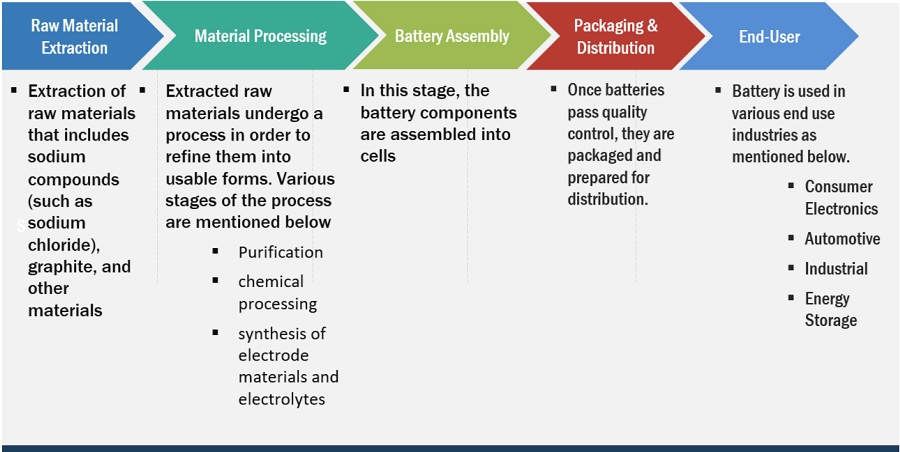
"Automotive, by end use industry, is estimated to grow at the fastest rate during the forecast period."
The automotive industry is expected to grow at the fastest rate among end-use industries for the sodium ion battery market. The market for sodium-ion batteries is expanding at the fastest pace in the automotive sector because of the marked trend towards electric transportation. The automobile industry's growing emphasis on sustainability and clean energy technology has fueled this shift. Due to their affordability, safety features, and advantages for the environment, sodium-ion batteries have become the go-to option in this industry. Government programs supporting sustainable energy and the necessity of grid modernization have contributed to the spike in demand for sodium-ion batteries in electric vehicles. Consequently, the automotive sector has become the fastest-growing sector within the sodium-ion battery business due to its acceptance of these batteries, which has fueled their rapid expansion and domination in the market.
"Non-Aqueous, by battery type, is estimated to grow at the fastest rate during the forecast period."
The non-aqueous sodium-ion batteries are growing at the fastest rate in the industry, and it can be attributed to their versatility and wide-ranging applications across various industries. This is because, in contrast to aqueous alternatives, non-aqueous electrolytes permit larger working voltages. Better voltages thus result in better energy densities, which are essential for long-range applications like grid storage and electric vehicles. Aqueous batteries have benefits including cost-effectiveness and safety, but because of their lower energy density, they are better suited for stationary applications with lesser power needs.
"Europe is estimated to account for the highest CAGR during the forecast period."
The Europe region demonstrates the fastest growing rate in the sodium ion battery market. The increasing use of electric vehicles and renewable energy initiatives is propelling this region's growth, especially in nations like Germany, UK, and France. To cut emissions and advance sustainable energy solutions, the need for sodium-ion batteries is growing in the transportation and power generation industries. Given the region's abundance of sodium and the growing focus on sustainability and environmental issues, sodium-ion batteries are seen as a promising technology with the potential to revolutionize the energy storage market.
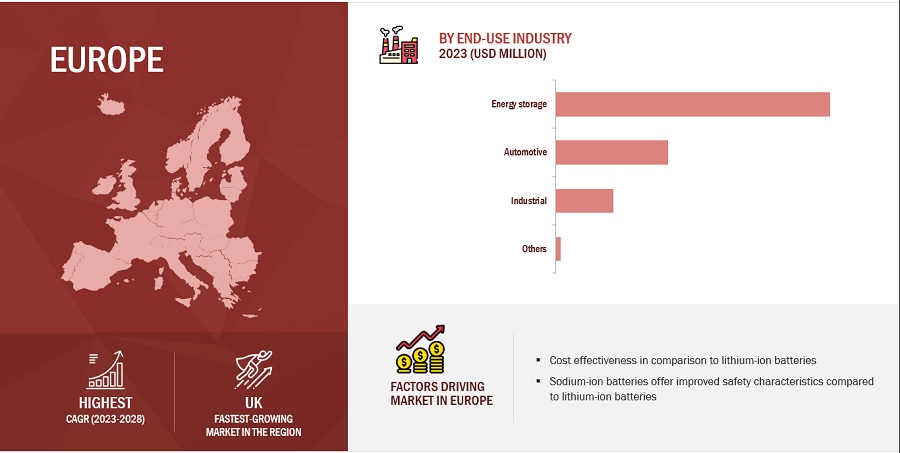
To know about the assumptions considered for the study, download the pdf brochure
Source: Secondary Research, Expert Interviews, and MarketsandMarkets Analysis
Sodium-Ion Battery Market Players
Major companies in the Sodium ion battery Market include Faradion (UK), Contemporary Amperex Technology Co., Ltd. (China), Tiamet Energy (France), HiNa Battery Technology Co., Ltd. (China) and Jiangsu Zoolnasm Energy Technology Co Ltd (China) and others. A total of 18 players have been covered. These players have adopted product launches, agreements, joint ventures, investments, acquisitions, mergers, and expansions as the major strategies to consolidate their position in the market.
Sodium-Ion Battery Market Report Scope
|
Report Metric |
Details |
|
Market Size Available for Years |
2019–2028 |
|
Base Year Considered |
2022 |
|
Forecast Period |
2023–2028 |
|
Forecast Units |
Value (USD Million/Billion) and Volume (Kilotons) |
|
Segments Covered |
Sodium Ion Battery Type, Technology Type, End-use, and Region |
|
Geographies Covered |
Asia Pacific, Europe, North America, the Middle East & Africa, and South America |
|
Companies Covered |
The major market players include Faradion (UK), Contemporary Amperex Technology Co., Ltd. (China), Tiamet Energy (France), HiNa Battery Technology Co., Ltd. (China) and Jiangsu Zoolnasm Energy Technology Co Ltd (China), NGK Insulators Ltd (Japan), Li-FUN Technology Corporation Limited (China), Zhejiang Natrium Energy Co., Ltd. (China), Natron Energy, Inc. (US), Jiangsu Transimage Sodium-lon Battery Technology Co., Ltd. (China) and others. |
This research report categorizes the Sodium Ion Battery Market based on Sodium Ion Battery Type, Technology Type, End-use, and Region.
Based on Battery Type, the Sodium Ion Battery Market has been segmented as follows:
- Sodium-Sulfur Batteries
- Sodium-Salt Batteries
- Sodium-Air Batteries
- Others
Based on Technology Type, the Sodium Ion Battery Market has been segmented as follows:
- Aqueous
- Non-Aqueous
- Others
Based on End Use, the Sodium Ion Battery Market has been segmented as follows:
- Automotive
- Industrial
- Energy Storage
- Others
Based on Region, the Sodium Ion Battery Market has been segmented as follows:
- Asia Pacific
- Europe
- North America
Recent Development
- In January 2024, JAC Group has made a groundbreaking move in the electric vehicle (EV) industry by introducing China's first mass-produced electric vehicle powered by sodium-ion batteries. This milestone delivery, part of the Yiwei brand, features cutting-edge sodium-ion cylindrical cells supplied by HiNa Battery Technology.
- In February 2024, Sodion Energy has introduced India's first Sodium Ion batteries, marking a significant advancement in energy storage technology. These Sodium Ion batteries are poised to revolutionize various sectors, including electric vehicles and home appliances, offering a versatile and sustainable energy storage solution.
- In March 2024, Contemporary Amperex Technology Co., Ltd. is planning to establish a research and development center in Hong Kong at the Hong Kong Science Park, with an expected recruitment of about 500 staff. The company's decision to set up a research base in Hong Kong is seen as strategic, leveraging the city's international hub status and talent pool while diversifying its markets globally.
Frequently Asked Questions (FAQ):
What is the key driver for the Sodium ion battery market?
Cost effectiveness of sodium ion batteries in comparison to the lithium-ion batteries is a driving force for the sodium ion battery market
Which region is expected to register the highest CAGR in the sodium ion battery market during the forecast period?
The Europe is estimated to register the highest CAGR during the forecast period.
What is the major source of Sodium ion battery?
Sodium, which is widely distributed and easily accessible in nature, is the main component in sodium-ion batteries. Compared to lithium, sodium is more widely available geographically and can be obtained from a variety of substances, including sea salt (NaCl). As sodium is abundant in saltwater and the earth's crust, it is a useful raw material for the manufacturing of sodium-ion batteries.
Who are the major players of the sodium ion battery market?
The key players operating in the market include Faradion (UK), Contemporary Amperex Technology Co., Ltd. (China), Tiamet Energy (France), HiNa Battery Technology Co., Ltd. (China) and Jiangsu Zoolnasm Energy Technology Co Ltd (China).
What is the total CAGR expected to record for the Sodium ion battery Market during 2023-2028?
The market is expected to record a CAGR of 21.5 % from 2023-2028. .
To speak to our analyst for a discussion on the above findings, click Speak to Analyst
The study involved four major activities in estimating the current size of the Sodium Ion Battery Market. Exhaustive secondary research was done to collect information on the market, peer markets, and parent market. The next step was to validate these findings, assumptions, and sizing with the industry experts across the Sodium Ion Battery value chain through primary research. Both top-down and bottom-up approaches were employed to estimate the complete market size. Thereafter, market breakdown and data triangulation were used to estimate the market size of segments and subsegments.
Secondary Research
Secondary sources for this research study include annual reports, press releases, and investor presentations of companies; white papers; certified publications; and articles by recognized authors; gold- and silver-standard websites; Sodium Ion Battery manufacturing companies, regulatory bodies, trade directories, and databases. The secondary research was mainly used to obtain key information about the industry’s supply chain, the total pool of key players, market classification, and segmentation according to industry trends to the bottom-most level and regional markets. It has also been used to obtain information about key developments from a market-oriented perspective.
Primary Research
The Sodium Ion Battery Market comprises several stakeholders, such as raw material suppliers, technology support providers, Sodium Ion Battery manufacturers, and regulatory organizations in the supply chain. Various primary sources from both the supply and demand sides of the market were interviewed to obtain qualitative and quantitative information. Primary sources from the supply side included industry experts such as Chief Executive Officers (CEOs), vice presidents, marketing directors, technology and innovation directors, and related key executives from various key companies and organizations operating in the Sodium Ion Battery Market. Primary sources from the demand side included directors, marketing heads, and purchase managers from various sourcing industries. Following is the breakdown of the primary respondents:
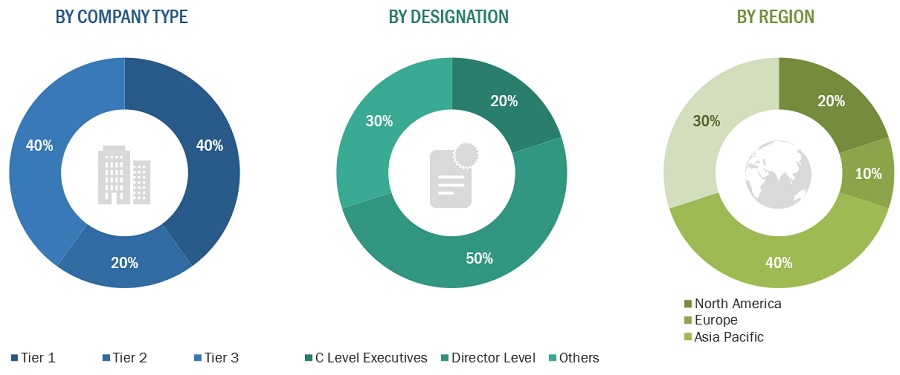
To know about the assumptions considered for the study, download the pdf brochure
Market Size Estimation
Both the top-down and bottom-up approaches have been used to estimate and validate the total size of the Sodium Ion Battery Market. These approaches have also been used extensively to estimate the size of various dependent subsegments of the market. The research methodology used to estimate the market size included the following:
The following segments provide details about the overall market size estimation process employed in this study:
- The key players in the market were identified through secondary research.
- The market shares in the respective regions were identified through primary and secondary research.
- The value chain and market size of the Sodium Ion Battery Market, in terms of value and volume, were determined through primary and secondary research.
- All percentage shares, splits, and breakdowns were determined using secondary sources and verified through primary sources.
- All possible parameters that affect the market covered in this research study were accounted for, viewed in extensive detail, verified through primary research, and analyzed to obtain the final quantitative and qualitative data.
- The research included the study of annual and financial reports of the top market players and interviews with industry experts, such as CEOs, VPs, directors, sales managers, and marketing executives, for key insights, both quantitative and qualitative.
Global Sodium Ion Battery Market Size: Bottom-Up Approach

To know about the assumptions considered for the study, Request for Free Sample Report
Global Sodium Ion Battery Market Size: Top-Down Approach

Data Triangulation
After arriving at the overall market size using the market size estimation processes as explained above, the market was split into several segments and sub-segments. To complete the overall market engineering process and arrive at the exact statistics of each market segment and subsegment, the data triangulation and market breakdown procedures were employed, wherever applicable. The data was triangulated by studying various factors and trends from both the demand and supply sides in the oil & gas sector.
Market Definition
A sodium-ion battery is a type of rechargeable battery that uses sodium ions as the charge carriers during the electrochemical reactions that occur within the battery cell. Sodium-ion batteries store and release electrical energy through the movement of ions between the negative and positive electrodes during charging and discharging cycles. In a sodium-ion battery, the cathode typically contains a sodium-based compound such as sodium cobalt oxide (NaCoO2) or sodium iron phosphate (NaFePO4), while the anode is often composed of materials capable of intercalating sodium ions, such as hard carbon (graphite-like carbon) or various metal alloys.
During charging, sodium ions are extracted from the cathode and migrate through the electrolyte to the anode electrode, where they are stored within the structure of the anode material. Conversely, during discharge, the stored sodium ions move back to the cathode electrode through the electrolyte, releasing electrical energy that can be used to power electronic devices or systems.
Key Stakeholders
- Raw material manufacturers
- Technology support providers
- Manufacturers of Sodium Ion Battery
- Traders, distributors, and suppliers
- Regulatory Bodies and Government Agencies
- Research & Development (R&D) Institutions
- End-use Industries
- Consulting Firms, Trade Associations, and Industry Bodies
- Investment Banks and Private Equity Firms
Report Objectives
- To analyze and forecast the market size of Sodium Ion Battery Market in terms of value and volume
- To provide detailed information regarding the major factors (drivers, restraints, challenges, and opportunities) influencing the regional market
- To analyze and forecast the global Sodium Ion Battery Market on the basis of Battery type, technology type, end-use, and region
- To analyze the opportunities in the market for stakeholders and provide details of a competitive landscape for market leaders
- To forecast the size of various market segments based on three major regions: Asia Pacific, Europe, and North America, along with their respective key countries
- To track and analyze the competitive developments, such as acquisitions, partnerships, collaborations, agreements and expansions in the market
- To strategically profile the key players and comprehensively analyze their market shares and core competencies
Available Customizations
With the given market data, MarketsandMarkets offers customizations according to the client-specific needs.
The following customization options are available for the report:
- Additional country-level analysis of the Sodium Ion Battery Market
- Profiling of additional market players (up to 5)
Product Analysis
- Product matrix, which gives a detailed comparison of the product portfolio of each company.











Growth opportunities and latent adjacency in Sodium-Ion Battery Market